- Details
- Flash Memory
Enterprise storage leader HGST, a Western Digital company, today announced its new series of NVMe-compliant Ultrastar SN100 PCIe SSDs. HGST’s NVMe PCIe SSDs, integrating Toshiba’s current MLC NAND Flash, will drive the next wave of application acceleration with simplified PCIe SSD system integration paired with HGST’s renowned quality and reliability. The standardized NVMe protocol for PCIe SSDs enables broad system interoperability and ease of deployment, resulting in lower cost of ownership.
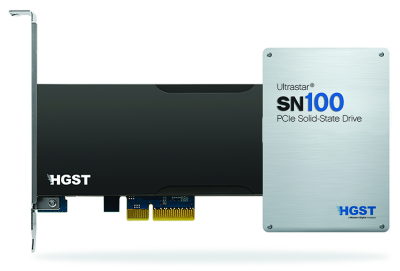
Targeting application and database acceleration, virtualization and big data analytics, the Ultrastar SN100 series of SSDs will be offered as a half-height, half-length (HH-HL) add-in card, as well as in a standard 2.5-inch drive form factor, with industry-leading capacities up to 3.2TB. For added NAND Flash endurance and reliability, the Ultrastar SN100 series will deploy HGST’s CellCare NAND management technology optimized for Toshiba MLC NAND Flash.
- Details
- Flash Memory
Enterprise storage leader HGST, a Western Digital company today announced it will extend the use of Intel NAND Flash technology as part of a cooperative agreement with Intel Corporation on Serial Attached SCSI (SAS) solid state drives (SSDs). Since 2008, HGST has successfully worked with Intel to develop industry-leading enterprise-class SAS SSDs for servers, workstations and storage systems. The resulting products have combined HGST’s enterprise storage experience with Intel’s NAND Flash expertise, and are the foundation for HGST’s leading position in SAS SSDs.
Intel’s focus and investment in NAND flash memory research and SSD development provides industry-leading advancements in next-generation NAND lithography and offers high-endurance SSD technology. HGST brings proven enterprise storage expertise in SAS design, firmware, reliability, customer qualification and system integration. This combination enables HGST to deliver world-class solutions with the performance, endurance and reliability that enterprise storage customer’s demand.
The combination of technologies from HGST and Intel has already resulted in four generations of successful HGST SAS SSDs. This announcement reflects HGST’s plans to continue use of Intel’s NAND Flash technology in HGST’s enterprise-class SAS SSDs for three more years. These solutions will continue to be marketed and sold exclusively by HGST, and are part of HGST’s comprehensive portfolio of HDDs, SSDs, software and solutions that help data center managers build tomorrow’s IT infrastructures today.
- Details
- Flash Memory
 OCZ Storage Solutions -- a Toshiba Group Company and leading provider of high-performance solid state drives (SSDs) for computing devices and systems, will unveil its latest storage solutions at the 2014 Intel Developer Forum (IDF), September 9-11 at Moscone West, San Francisco. New drives to be showcased include the upcoming Saber 1000 SATA III Series which is designed to deliver the best cost per GB for hyperscale data center customers, and the innovative Z-Drive 6000 2.5-inch PCIe 3.0 NVMe series that provides industry-leading IOPS per dollar.
OCZ Storage Solutions -- a Toshiba Group Company and leading provider of high-performance solid state drives (SSDs) for computing devices and systems, will unveil its latest storage solutions at the 2014 Intel Developer Forum (IDF), September 9-11 at Moscone West, San Francisco. New drives to be showcased include the upcoming Saber 1000 SATA III Series which is designed to deliver the best cost per GB for hyperscale data center customers, and the innovative Z-Drive 6000 2.5-inch PCIe 3.0 NVMe series that provides industry-leading IOPS per dollar.
OCZ has long been a major supplier to customers in the hyperscale and cloud markets, and the new Saber 1000 SATA III SSD was conceptualized and designed with key input from customers within this space to offer the best of both worlds with an enterprise-optimized feature-set, high capacity, and exceptional price point. Because these massive scalable infrastructures require premium yet practical storage, Saber 1000 is designed to be a more cost-effective solution than traditional enterprise-grade SSDs, effectively eliminating I/O bottlenecks and maximizing storage efficiency to meet the evolving demands of the fast growing hyperscale and cloud computing markets. Based off the proven OCZ Barefoot 3 platform which delivers superior and sustainable performance, Saber 1000 also provides enhanced data integrity with the addition of features like partial power fail protection and will also leverage the latest generation A19 NAND flash from Toshiba.
- Details
- Flash Memory
 SanDisk Corporation, a global leader in flash memory storage solutions, today announced that SanDisk DAS Cache software will be offered by Dell for use in its next generation Dell PowerEdge servers with direct-attached storage (DAS). This all-software solution will allow customers to benefit from the high performance of solid state drives (SSDs), while maintaining data on direct-attached, disk-based storage. SanDisk DAS Cache software works with SSDs from any manufacturer, empowering customers to select the SSD capacity and performance that is appropriate to their data center needs.
SanDisk Corporation, a global leader in flash memory storage solutions, today announced that SanDisk DAS Cache software will be offered by Dell for use in its next generation Dell PowerEdge servers with direct-attached storage (DAS). This all-software solution will allow customers to benefit from the high performance of solid state drives (SSDs), while maintaining data on direct-attached, disk-based storage. SanDisk DAS Cache software works with SSDs from any manufacturer, empowering customers to select the SSD capacity and performance that is appropriate to their data center needs.
“We have been working very closely with Dell to provide a complete solution for their customers that provides the performance and cost benefits of solid-state storage technology,” said John Scaramuzzo, senior vice president and general manager, Enterprise Storage Solutions, SanDisk. “Combining innovations in both hardware and software enables customers to realize the full potential of enterprise storage solutions. We are excited that Dell is able to offer the benefits of our SanDisk DAS Cache software to customers with its new PowerEdge servers.”
- Details
- Flash Memory
Lexar, a leading global brand of flash memory products, has enhanced its Professional Workflow line with the introduction of the new Lexar Professional Workflow UR1, a three-slot microSDHC/microSDXC UHS-I USB 3.0 reader. The new reader quickly transfers 4K video and other large media files from three cards at once.
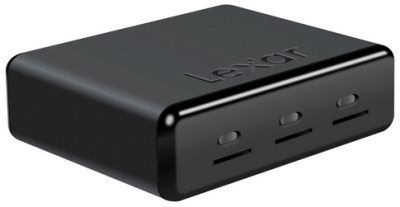
Designed for professional photographers, videographers, and adventure seekers, the reader is a great option for those who need to offload video from sports camcorders and cameras, which require multiple memory cards for extended shooting. When populating all four bays of the customizable Lexar Professional Workflow hub, users can quickly move files from up to 12 cards at once.
- Details
- Flash Memory
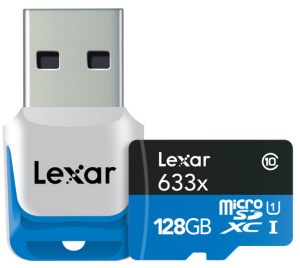 Lexar, a leading global brand of flash memory products, today announced the new 128GB Lexar High-Performance microSDXC UHS-I card with read transfer speeds up to 633x (95MB per second). Designed for sports camcorders, tablets and smartphones, the Class 10 microSDXC card can capture up to 15 hours of HD video.
Lexar, a leading global brand of flash memory products, today announced the new 128GB Lexar High-Performance microSDXC UHS-I card with read transfer speeds up to 633x (95MB per second). Designed for sports camcorders, tablets and smartphones, the Class 10 microSDXC card can capture up to 15 hours of HD video.
“Whether it’s on a sports camera, aerial camera, tablet or smartphone, more video is being captured than ever before,” said Adam Kaufman, director of card product marketing, Lexar. “With the new Lexar 128GB microSDXC UHS-I card, users can continue to capture and store high-quality content, without having to worry about changing cards or running out of space.”
The 128GB Lexar High-Performance microSDXC UHS-I card (633x) comes with a USB 3.0 reader and allows for high-speed file transfer of photos and videos from the card to a PC or Mac. The reader is also backwards compatible with USB 2.0 ports and comes with a one-year limited warranty.
- Details
- Flash Memory
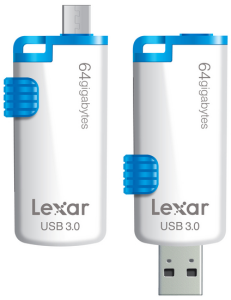 Lexar, a leading global brand of flash memory products, today announced the Lexar JumpDrive M20 Mobile USB 3.0 flash drive. Featuring two connectors – micro-USB and USB 3.0 – the new drive allows users to easily transfer playlists, photos, videos, and files with On-The-Go (OTG)-enabled Android tablets or smartphones without the use of cables or Wi-Fi.
Lexar, a leading global brand of flash memory products, today announced the Lexar JumpDrive M20 Mobile USB 3.0 flash drive. Featuring two connectors – micro-USB and USB 3.0 – the new drive allows users to easily transfer playlists, photos, videos, and files with On-The-Go (OTG)-enabled Android tablets or smartphones without the use of cables or Wi-Fi.
The Lexar JumpDrive M20 Mobile offers read speeds of up to 120MB/s and can transfer a 3GB HD video clip in less than one minute – a faster and more convenient solution than using Wi-Fi or data connectivity. The drive sports a thumb slide design to retract both connectors and is backwards compatible with USB 2.0 devices.
“Smartphones and tablets have made it easier for consumers to access their music, videos, and other files anytime, anywhere. But in the past, access required either a Wi-Fi connection or data usage,” said Aaron Lee, director of USB product marketing, Lexar. “The new JumpDrive M20 Mobile USB 3.0 flash drive lets consumers not only quickly retrieve, but share and transfer digital files on the go and between devices – all without searching for a hotspot, using data, or plugging in.”
- Details
- Flash Memory
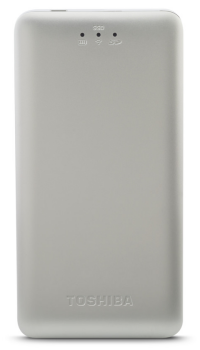 Toshiba Europe GmbH (TEG) Storage Peripherals Division today announces the launch of the Canvio AeroMobile wireless SSD, combining the convenience and capacity of portable storage with the durability and performance of solid state drives. The pocket-sized SSD has integrated wireless functionality and a high-speed USB 3.0 port, allowing you to transfer your precious data seamlessly between up to eight devices at a time - wherever you are.
Toshiba Europe GmbH (TEG) Storage Peripherals Division today announces the launch of the Canvio AeroMobile wireless SSD, combining the convenience and capacity of portable storage with the durability and performance of solid state drives. The pocket-sized SSD has integrated wireless functionality and a high-speed USB 3.0 port, allowing you to transfer your precious data seamlessly between up to eight devices at a time - wherever you are.
Available in light gold, the stylish Canvio AeroMobile is the must-have central storage hub for your smartphone, laptop, tablet and PC. Offering 128 GB[1] of storage, the SSD comes with expanded memory via the built-in SD card slot - doubling as a backup solution for your holiday snaps, family videos and personal data. For added peace of mind, SSD technology resists shocks and vibrations better than conventional drives and the improved battery life allows for up to 8 hours of continuous video streaming.
With a light and compact design, the Canvio AeroMobile wireless SSD is small enough to carry in your pocket so you can quickly store, share and stream your digital treasures with ease, making it your own personal cloud to carry with you all the time and ensure your data, whether it is for work or play, is supported. Download the Toshiba Wireless SSD app for your Android or iOS mobile device and browse, save or stream files on the move. The Internet Pass-Thru Mode also means browsing the web and accessing the Canvio AeroMobile wireless SSD can be done simultaneously.
- Details
- Flash Memory
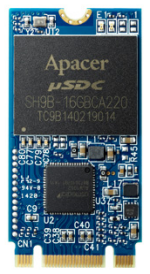 Since the PCIe SSD was adopted by Apple as a standard accessory in MacBook Air in 2013, its excellent flash storage performance featuring high-speed transmission has led the competition to follow, including the fully PCIe SSD-supported Microsoft Windows 8.1 operating system and the new generation Intel CPU chip. According to a survey conducted by the global market research firm TrendForce, the transmission speed of PCIe G2 (PCIe Generation 2.0) surpassed that of SATA III SSD in 2014. Moreover, several high-end notebooks are expected to replace SATA III SSD with PCIe SSD since Apple and Microsoft are boosting the market demand. With the price gap between them shrinking, PCIe G2 will potentially become the mainstream specification in the PC SSD market in 2015.
Since the PCIe SSD was adopted by Apple as a standard accessory in MacBook Air in 2013, its excellent flash storage performance featuring high-speed transmission has led the competition to follow, including the fully PCIe SSD-supported Microsoft Windows 8.1 operating system and the new generation Intel CPU chip. According to a survey conducted by the global market research firm TrendForce, the transmission speed of PCIe G2 (PCIe Generation 2.0) surpassed that of SATA III SSD in 2014. Moreover, several high-end notebooks are expected to replace SATA III SSD with PCIe SSD since Apple and Microsoft are boosting the market demand. With the price gap between them shrinking, PCIe G2 will potentially become the mainstream specification in the PC SSD market in 2015.
As a quick response to market demand, Apacer launches two PCIe-interface products, including an mPDM+ and an M.2 PCIe SSD. The mPDM+ is a mini PCIe SSD with the dimensions in line with that of mSATA products. The 50.8x29.8mm size can be a perfect substitute for the storage device of mSATA attached to the motherboard. M.2 PCIe SSD, on the other hand, is about 40% smaller than the mSATA SSD module in dimensions of only 22x42mm. As M.2 SSD module has been included in standard interface, and supports both the transmission signals from SATA and PCIe. PCIe boasts transmission bandwidth and speed far beyond that of SATA, achieving higher transmission efficiency than that of SATA 6Gbps. With high compatibility, both these two PCIe SSDs match AHCI (Advanced Host Controller Interface), which ensures their competitive edge.
- Details
- Flash Memory
 Seagate Technology plc, a world leader in storage solutions, today announced it has completed its previously announced acquisition of the assets of LSI’s Accelerated Solutions Division (“ASD”) and Flash Components Division (“FCD”) from Avago Technologies Limited.
Seagate Technology plc, a world leader in storage solutions, today announced it has completed its previously announced acquisition of the assets of LSI’s Accelerated Solutions Division (“ASD”) and Flash Components Division (“FCD”) from Avago Technologies Limited.
“There is a growing opportunity for mobile and enterprise flash-based storage solutions, which is why we’re excited about this strategic technology acquisition,” said Steve Luczo, Seagate Chairman and CEO. “Integrating LSI’s Enterprise PCIe flash and SSD controller products, and its engineering capabilities into Seagate’s leading storage technology portfolio and product development will expand our ability to meet a broader base of customers’ needs and drive new revenue opportunities.”
This technology acquisition immediately boosts Seagate’s range and depth of flash storage capabilities and brings additional engineering expertise to accelerate its roadmap in the growing flash market. LSI’s ASD business has the broadest PCIe flash product offering and intellectual property in the market today and its FCD business has best-in-class SSD controllers with proven support for a wide range of applications.
Add a comment
